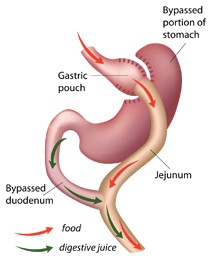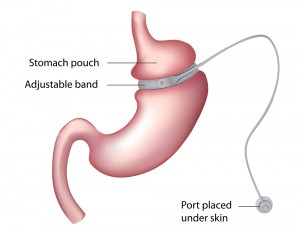What can Patients Who Fail to Lose Weight after Roux-en-Y Gastric Bypass Surgery do to be Successful in Future Weight Loss? — Dr. Christine Ren-Fielding
UncategorizedLAGB as an option for Patients who have Failed to Lose Weight After Roux-en-Y Gastric Bypass
Patients struggling with obesity often choose surgery to help them lose weight and resolve comorbidities that arise from obesity. But what happens if patients fail to lose weight after a procedure? A study by Dr. Christine Ren-Fielding, Dr. George Fielding and other doctors at NYU Langone Medical Center explored this question. Specifically, the doctors assessed whether or not patients who fail to lose weight after Roux-en-Y Gastric Bypass (RYGBP) could be successful by having Laparoscopic Adjustable Gastric Band Surgery (LAGB) as a salvage procedure.
RYGBP vs. LAGB
While there are several types of bariatric surgery, this study focused on two: Roux-en-Y Gastric Bypass and Laparoscopic Adjustable Gastric Band surgery.
RYGBP surgery does two things: it reduces the size of the stomach and reroutes the intestines. This limits the amount of food patients are able to eat and calories they absorb.
LAGB is a procedure that places a small, adjustable band around the top of the stomach. This band is adjusted using saline solution. A small pouch is created where food is digested and this smaller area results in the nerves in the stomach more quickly notifying the brain that the patient is full thus resulting in less food eaten and a feeling of satiety coming much earlier than without the band.
Study Overview
This study reviewed outcomes of LAGB placements in patients who failed to lose weight after RYGBP. Patient data was collected prospectively and entered into an electronic registry. Researchers, like Dr. Christine Ren-Fielding and Dr. George Fielding, evaluated:
Preoperative age and BMI
Gender
Percentage of excess weight loss (EWL)
Postoperative complications
Eleven patients (seven female, four male) were referred to NYU Langone Medical Center bariatric surgeons, like Dr. Christine Ren-Fielding and Dr. George Fielding, and specifically the Weight Management Program after they failed to lose weight after RYGBP. Of the initial surgeries about half were open and half were laparoscopic. All patients were referred to NYU Langone Medical Center because of persistent morbid obesity due to weight loss failure or because they regained weight.
The data on these patients was as follows:
Average preoperative age: 39.5 years old
BMI: 53.2
EWL after RYGBP: 38%
The average time between the two procedures was 5.5 years with the average age at the time of the second surgery 46.1 years old. Average BMI before the second procedure was an average of 43.4. Most of the salvage surgeries saw the bands placed laparoscopically. There were no complications from any of the surgeries. There were neither band slips nor erosions.
Findings
Dr. Christine Ren-Fielding, Dr. George Fielding, and their colleagues are encouraged by the findings. The average follow-up after LAGB was 13 months and saw the following:
Average BMI: 37.1
Average EWL: 59%
Patients who had the LAGB done as a salvage for RYGBP lost an additional 20.8%.
LAGB was found to be a safe and effective solution for patients to seek if they fail to lose weight from RYGBP.
If you are interested in learning more about your weight loss options, including the work of Dr. Christine Ren-Fielding and Dr. George Fielding, learn more by visiting NYU Langone Weight Management Program here.


No comments yet.